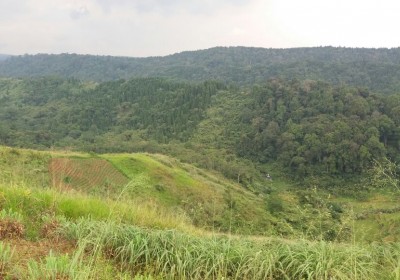Become Empowered Through Social Forestry
May 22, 2018
Lands that are covered only by less than 10 percent vegetation will be utilized as Social Forestry. (Source: Indonesian Forestry Foundation)
Sujiyem, a farmer from Ngimbang, Palang, Tuban, can now smile broadly after having a big corn harvest from the Social Forestry program. He grew corn as side plants between his teak trees. From one harvest he can get proceeds amounting to Rp 6 million to Rp 8 million. Formerly, he was only a farm laborer who did not have any land.
"We just received the Decision Letter on Social Forestry in Madiun last November. Within five months, we had our corn harvest. Alhamdulilah, this program can provide the daily needs of our family," said Sujiyem to JPNN.com, Friday, March 9, 2018.
Social forestry is a national program of the Ministry of Environment and Forestry (MEF) which aims to create economic equity and reduce economic inequality through three pillars. EF Minister Siti Nurbaya Bakar said the three pillars are land or natural resources, business opportunity, and human resource capacity building.
Minister Siti said these three pillars make people not only work but also earn income by cluster or group approach which in turn drives local economic growth. Individually or in groups, communities become more productive so that the economic gap of individuals and regions can be significantly reduced.
"Before President Jokowi’s administration, 96 percent the license to utilize forest areas were held by big corporations and managed for business purposes, while only 4 percent was managed by community. This Social Forestry Program aims at allocating only 69-71 percent of forest areas for business, while the remaining 29-31 percent will be reserved for the community,” said Siti Nurbaya when interviewed at her office, early May 2018 .
As a result, said Siti Nurbaya, farmers' income increased. In fact, the turnover reaches billions of dollars. Social Forestry proves to be a solution that can help reduce economic gaps. Similar solutions are expected to be presented in the 2018 Indonesia Development Forum.
The 2018 IDF was initiated by Bappenas and supported by the Australian Government through the Knowledge Sector Initiative aims to maintain sustainable development based on science, experience and facts to support the acceleration of development in Indonesia and to make it more equitable and sustainable. The forum will be titled 'Pathways to Tackle Regional Disparities Across The Archipelago.
The director of Indonesian Forestry Foundation, Siti Fikriyah Khuryati, confirmed that the Social Forestry Program can help reduce the gap between regions and stimulate the establishment of new centers of economic growth. According to her, there are three parties who will benefit financially from the social forestry program.
The first is the forest farmers who will have access to utilize the forest. Second, the area or village where the social forestry farmers reside. Farmers who earn income, said Fikri, will move the wheels of the village economy. Third, social forestry will encourage industrialization in the village area, thereby creating new employment opportunities.
"There will be a plywood factory there, a food processing from cash crop and others," she said.
Not only the economic aspect, Fikri said, the Social Forestry Program will also bring social and ecological impact. The social impacts on the farmers will include income they can raise to provide welfare and education to their children. It is hoped that these children will help build the village and the region. Proceeds from well-managed Social Forestry results can also be used to build village infrastructure independently.
On the other hand, Fikri said that the ecological impact of Social Forestry will be the rehabilitation of lands as forest farmers will conduct reforestation. Under Ministerial Regulation No. 39 of 2017, the land allowed to be used for social forest is only that with less than 10 percent coverage. This area should be planted mainly with timber plants, followed by fruit crops, and finally, cash crops in the remaining empty space for quick harvest. Forest farmers can manage it for 35 years.
“Ministerial Regulation Number 39 sets forth a guidelines for the implementation of Social Forestry which does not only focus on economic benefits of forest but also on its function to support environmental conservation," said Fikri.
The Ministry of Environment and Forestry aims at targeting 12.7 million hectares to be utilized as social forest. Government’s assistance is expected to come not only in the form of provision of land but also in the support to access the financing schemes provided by financial institutions, such as state owned banks and to bring farmers closer to offtakes, both the State-Owned Enterprises and private corporations.
For example, the state owned enterprise PT Perkebunan Nusantara is one of the purchasers for tobacco and sugarcane. Another example is Bulog (National Logistical Agency) that buys rice and maize Social Forest Concession (IPHPS) in Probolinggo. In addition, the Indonesian Fishery Agency also buys from IPHPS Muara Gembong shrimp ponds, Bekasi.
Indonesia’s Research Institutions Supporting the Development of the Electric Vehicle Industry
Indonesian Muslim Fashion and Cosmetics IKMs Shine at Dubai World Expo 2020
Govt Steps Up UMKM Transformation Efforts in the Midst of Pandemic Slowdown
Govt Encourages Promotion of IKM Products in Digital Era
Government Begins Developing Maritime Training Center in Makassar
Tweets by IDDevForum
